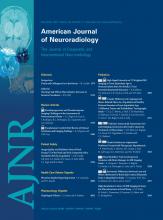Data supplements
Supplemental Online Figures and Videos
Files in this Data Supplement:
- Online Figures 1-8 (PDF) -
Online Figure 1: Anatomical illustration of the selected ROIs for motion index and vessel volume change analysis. Eight anatomic locations were selected for analysis.
Online Figure 2: Reconstruction of the pulse wave of the right ICA. The mean ± SD of vessel volume change in the right ICA during a single heartbeat of 10 subjects is shown. There were 2 peaks; the first peak was in 30% or 40% in the R-R interval, and the second was in 70%. The lowest peak was in 90%. There was a significant difference in the vessel volume between the higher phase and the lower phase. * indicates P < .05.
Online Figure 3: Reconstruction of the pulse wave of the left ICA. The mean ± SD of vessel volume change in the left ICA during a single heartbeat of 10 subjects is shown. There were 2 peaks; the first peak was in 40% in the R-R interval, and the second was in 70%. The lowest peak was in 90%. There was a significant difference in vessel volume between the higher phase and the lower phase. * indicates P < .05.
Online Figure 4: Reconstruction of the pulse wave of the right MCA. The mean ± SD of vessel volume change of the right MCA during a single heartbeat of 10 subjects is shown. There were 2 peaks; the first peak was in 30% in the R-R interval, and the second was in 70%. The lowest peak was in 10%. There was a significant difference in vessel volume between the higher phase and the lower phase. * indicates P <.05.
Online Figure 5: Reconstruction of the pulse wave of the left MCA. The mean ± SD of vessel volume change of the left MCA during a single heartbeat of 10 subjects is shown. There were 2 peaks; the first peak was in 40% in the R-R interval, and the second was in 80%. The lowest peak was in 90%. There was no significant difference in vessel volume between the higher phase and the lower phase.
Online Figure 6: Reconstruction of the pulse wave of the Acom. The mean ± SD of vessel volume change of the Acom during a single heartbeat of 10 subjects is shown. There were 2 peaks; the first peak was in 30% in the R-R interval, and the second was in 70%. The lowest peak was in 90%. There was a significant difference in vessel volume between the higher phase and the lower phase. * indicates P <.05.
Online Figure 7: Reconstruction of the pulse wave of the BA bifurcation. The mean ± SD of vessel volume change of the BA bifurcation during a single heartbeat of 10 subjects is shown. There were 2 peaks; the first peak was in 30% in the R-R interval, and the second was in 70%. The lowest peak was in 0%. There was a significant difference in vessel volume between the higher phase and the lower phase. * indicates P <.05.
Online Figure 8: Reconstruction of the pulse wave of the right PCA. The mean ± SD of vessel volume change of the right PCA during a single heartbeat of 10 subjects is shown. There were 2 peaks; the first peak was in 40% in the R-R interval, and the second was in 80%. The lowest peak was in 90%. There was a significant difference in vessel volume between the higher phase and the lower phase. * indicates P < .05. - Online Video 1 (SWF)
-
3D presentation of the motion map. A short video of the 3-dimensional
presentation of the motion map. The �CORE� is red and the "HALO" is translucent white. Locations with less HALO can be identified.
Right click video; select Play. - Online Video 2 (SWF)
-
Movie showing the pulsations of the cerebral arteries. A short video of the cerebral artery pulsation. This movie was reconstructed
using the 4D-CTA data and software provided by Toshiba. Locations with less HALO can be identified.
Right click video; select Play.
- Online Figures 1-8 (PDF) -












